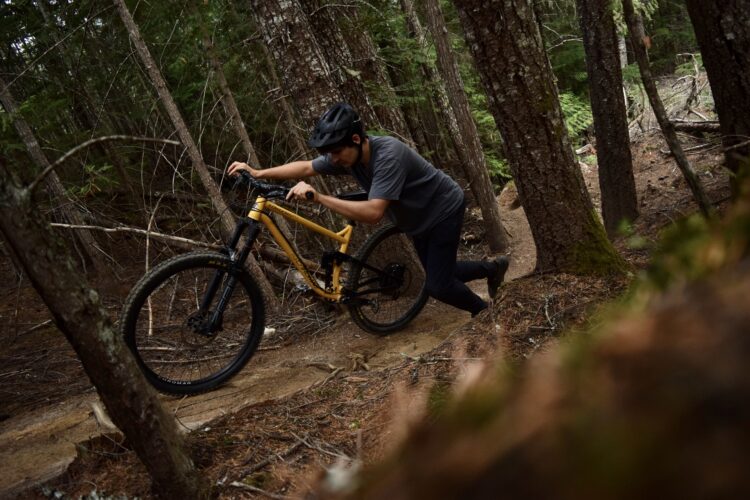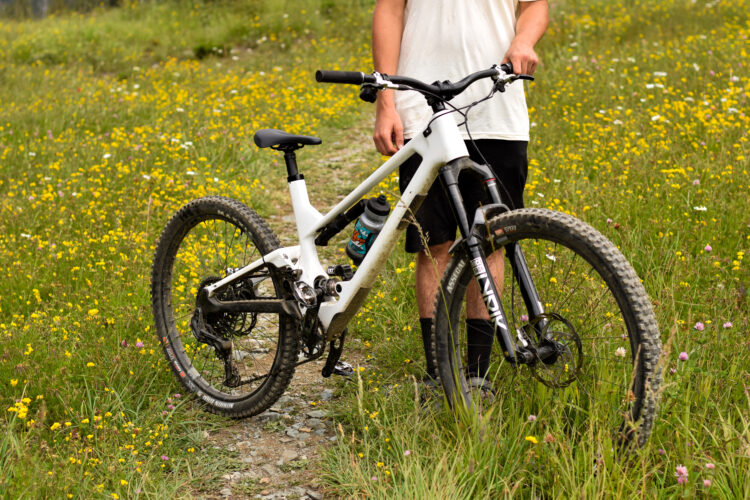The latest version of the Trek Slash enduro sled is here, and it comes with some major updates. Slimming down their lineup somewhat lately, with fewer available wheelsizes and refining what’s left, means a more purposeful and refined range of bikes, and oh boy does the new Slash come with a renewed sense of purpose.
Taking some major design influences from the Session, it’s clear to see that the new Slash’s favorite direction is down, with the rigors of modern enduro racing in mind. Trek describe the new Slash as a ‘big-mountain beast,’ it looks like it would be equally at home in the bike park as an enduro course and probably wouldn’t be shy to use the word ‘freeride’ on its dating profile. Either way, let’s get into what’s new and what makes the Slash generation 6 an even bigger bruiser of a bike than before.

Slash Bike Check
Getting right into the important facts and numbers, the new Slash is available in both aluminum and carbon, and frame sizes small through XL. Rear travel increases to 170mm compared to 160mm on the previous generation and remains at 170mm up front. It drops 0.6º off the head tube angle down to 63.5º with the option of running different cups to go another degree slacker or steeper. It comes out of the box with a mixed-wheel setup with the option of going full 29″ by swapping the lower shock mount, and the size small comes setup 27.5″ wheels front and rear, plus geometry changes that should improve handling across the board for every rider size.
Oh, and the biggest news, it’s now a high-pivot, much like its big brother the Session. While the session retains its classic lines however, the Slash is an altogether new beast, with a totally different look, and ride characteristic.
In Trek’s press release, they describe their target demographic as “All-mountain rippers, enduro racers, park riders, and anyone else who wants to conquer the wildest descents and be able to pedal back up for more.”

Geometry
The latest Slash mostly follows the usual trends of longer, lower, slacker, but the head tube angle is the most drastically different number, dropping down to 63.5º with the option to go up to 64.5º or way down to 62.5º with a different set of headset cups. Note, however, that these cups need to be pressed into the frame, so it’s not a quick home-mechanic job.
In their middle-ground ML size (18.5″), the reach is actually a touch shorter than the old bike at 468mm, the seat tube angle has steepened to 77.3º and the stack is 10mm higher at 632mm. The BB drop is somewhere between the older bike’s high/low settings at 27mmm while chainstays are size-specific, and within a millimetre of the old bike at 434mm. The wheelbase has grown longer by 10mm to 1253mm.

Suspension
The high pivot suspension design is the big news for the new Slash, and it was only a matter of time since the Session went high pivot. High pivot bikes are known for their exceptional ground-hugging grip qualities, though not necessarily for pedalling efficiency or for being particularly dynamic to ride. High pivot bikes utilize a rearward axle path, rather than one that moves upward or forward under compression. This means that the rear wheel tracks over bumps much more easily, resulting in an extremely smooth ride with a ton of grip.
Trek uses an oversized up idler pulley to decrease pedal kickback and to maintain pedal efficiency, as well as a lower idler pulley to isolate derailleur movement and to prevent the derailleur clutch from fighting suspension movement.
While the new Slash is quite a departure from the old bike, the new version still uses Trek’s ABP suspension system, albeit with the pivots in a slightly different location. ABP stands for “Active Braking Pivot,” where the rearmost pivot is concentric around the rear axle, isolating braking forces from the suspension, and keeping the suspension active even under braking.

One of the most interesting parts of the suspension kinematics on the Slash is the anti-squat curve. Anti-squat describes how the suspension resists squatting under pedalling and is a major factor in pedalling efficiency. The previous generation started at roughly 85% anti-squat but dropped to about 70% in the sag range and as low as 20% deeper into the travel. The new Slash sits between 95-105% through its entire range, resulting in a bike that should isolate pedalling and suspension forces really well.
In terms of leverage, the Slash has a progressive leverage ratio which starts to flatten off toward the end, presumably to give the bike a more ‘coil-like’ feeling, though riders will be able to dial in some bottom-out resistance with the new Vivid Air shock. The frame also has a leverage adjust chip which allows riders to choose between a more or less progressive leverage ratio to suit their desired feel.

Trek Slash frame details
Aesthetically the new Slash marks a significant departure from the old bike, a frame design which hadn’t changed much in a while. Looks aren’t everything though; there are some very smart features integrated into this frame. The Slash has options for multiple setups, such as the already mentioned swappable headset angle cups and lower shock mount for mixed or 29″ wheel sizes and is designed around a SRAM UDH with multiple Transmission build specs available.
The downtube thankfully still has a big hole in it for snacks and spares storage, and the chainstays and underside of the downtube feature some nice molded plastic/rubber ‘dual density’ guards to keep things quiet and protected. The downtube also features an additional layer of impact resistance underneath the paint as part of the frame’s construction which is a smart idea. The cables all run internally as per previous models, and carbon frames utilize ‘chunnels’ — tube-in-tube cable routing — making for easy brake hose/shift cable installation. And yes it is mechanical drivetrain compatible.
Thanks to the new suspension layout and the super straight seat tube, the dropper insertion has increased by around 80mm in all sizes, meaning a size medium frame can slam a 200mm post to full insertion and plenty of drop for all frame sizes. Hallelujah.

Trek Slash specs and pricing
The Gen 6 Slash is available as either frame-only or full build in both carbon and aluminum options. All builds apart from the Slash 8 come with the new Rockshox Vivid Air shock, the suspension brand’s new high-volume, gravity-focused shock.
The aluminum builds start with the Slash 8 XT at $4,399 and this is the only Fox build spec with a Performance 38 fork, Float X shock, and a Shimano Deore and Deore XT mixed drivetrain and Shimano brakes.
The Slash 9 GX AXS looks to be a crowd pleaser, priced at $5,799 and featuring a Rockshox Zeb and Vivid Select+ suspension package. For drivetrain it runs the SRAM GX Eagle Transmission group and stops with Code Bronze brakes for a really well specced alloy build. Both bikes come with Bontrager Line Comp 30 aluminum wheels.
The Slash 9.8 comes with the option of an XT build kit priced at $7,399 or GX for $7,999, both coming with the Select+ Zeb and Vivid, Bontrager’s Line Elite 30 carbon wheels and a Shimano XT 12sp drivetrain and brakeset or GX Transmission with Code Bronze brakes.
The Slash 9.9 has X0, XTR, and XX built options, coming in at $9,399, $9,599 and $11,499 respectively. The X0 and XTR builds come with Rockshox Zeb and Vivid Ultimate suspension, carbon handlebars, Line Pro 30 carbon wheels and their respective drivetrain options, with the X0 build running Code Silver brakes and an AXS Reverb dropper post rather than the Bontrager Line Elite dropper. The top spec 9.9 runs the XX Transmission groupset, Code Ultimate brakes, AXS Reverb and the Bontrager RSL one-piece carbon bar/stem combo for the ultimate in blingy enduro rigs.

First ride impressions
I managed to get a brief ride on the new Trek Slash in the 9.9 X0 build spec to put together some ride impressions. As always, it’s worth noting that this was a relatively short test ride on trails that were not my locals (though familiar-ish), during Whistler Crankworx on probably the wettest day of the entire summer.
Despite the weather being particularly foul, I got enough of a ride aboard the new Slash to figure out where it shines. The trails were a mix of singletrack and forest service road climbs into black-level descents with steep sections, rock rolls and slabs, and a decent amount of wet roots.
On the climb, the sensation was unlike anything else I’ve ridden before. The cranks on the large bike I was riding were 165mm in length, shorter than the 170mm that’s the usual spec choice. This definitely made for an interesting feeling, spinning smaller, faster circles. The suspension felt fairly efficient while sitting and spinning with very little bob, as expected, but the bike also felt slow, as I’d expect from a big travel bike, with noticeable drag from the idler pulleys. When rolling over roots and obstacles rather than bumping and hanging up on them, I could feel the rear wheel tracking around and over, giving plenty of grip and resulting in very few wheel-spin scenarios, despite the slippery conditions.
While the bike felt efficient, standing up on the pedals to generate more power/speed resulted in the bike feeling bogged down and did little to improve climbing progress. I got the impression that it’s more of a sit and spin type bike, though even on chunky, loose climbs it tracked well and gave me the feeling that as long as I could keep putting power down and choose my lines well, it would crawl up almost anything.
Pointing the bike downhill was equally interesting, where the feeling I got from the climb didn’t quite translate in the way I thought it might. Again, despite very wet conditions and an unfamiliar bike, as soon as I let off the brakes, the Slash generated speed incredibly well, giving me confidence to ride harder than usual. The back end did a lot to smooth out the trail and where I was expecting a rough ride, the Slash simply felt smooth and controlled, pushing me to ride harder and faster.

In areas where I expected the rear wheel to slip, for example wet roots, it tracked incredibly well and provided more grip than expected, resulting in a really planted and stable feeling. Not only this but I felt like the Slash picked up speed much faster and more easily than other bikes, perhaps thanks to the way the rear wheel moves out of the way of obstacles rather than into them.
While many high pivot bikes can feel ‘dead’ to ride, staying glued to the ground and devoid of any ‘pop,’ the Slash felt firm and precise with a platform that I could push into to pump and jump and easily load up through corners. The result is a bike that felt something like a big trail bike that was able to smooth out much rougher sections of trail while remaining fun.
I’d be interested to try the Slash over a longer test period on some steeper, more technical trails that I’m more familiar with, but the first impression was good. I found excellent descending characteristics and a refined feeling suspension package, though I did notice some sort of knocking coming from the back end that I couldn’t pinpoint.
Since the new Fuel EX has moved up in travel, the new Slash seems to have moved up as well, to a more gravity-focused segment where descending is prioritized over its climbing ability.





















2 Comments
Sep 7, 2023
Sep 7, 2023